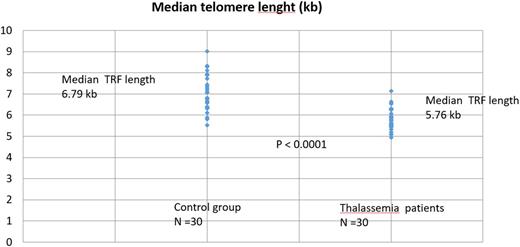Abstract
BACKGROUND
Transfusion dependent thalassemia (TDT) patients is a group of thalassemia patients who require regular blood transfusion. Red blood cell transfusion and increased intestinal iron absorption leads to iron overload. The cellular damage associated with iron overload is mainly mediated by the state of oxidative stress and the effect of free oxygen radicals on various cell components. Telomeres are terminal protein-DNA complexes that stabilize chromosome and prevent DNA from double-stranded breaks. Chronic oxidative stress from iron overload and ineffective erythropoiesis in thalassemia may lead to shortening of telomere length.
METHOD
We conducted a cross-sectional study in TDT patients aged more than 18 years old who attended the adult hematology clinic at Maharaj Nakorn Chiang Mai hospital, Chiang Mai University, Thailand from 1 January 2016 to 30 April 2016. TDT was defined as thalassemia who requiring a red cell transfusion at least 3 times per year, included both beta-thalassemia and alpha-thalassemia patients. Telomere length was measured by real-time quantitative PCR and compared with matched healthy controls by age and sex. We used Pearson's correlation coefficient to test whether telomere length was associated with any factors. The threshold for statistical significance for all comparisons was chosen as P <0.05.
RESULT
Thirty TDT patients and 30 matched healthy control were included in this study. For TDT group, there were 19 female patients (63.3%). The median age was 29.2 (18-48) years. Baseline hemoglobin pre-transfusion 6.4 g/dL (5.3-7.4). Of these, there were 18 beta-thalassemia/Hb E disease (60%) who was the majority population. There were 11 beta-thalassemia major patients (36.4%) and 1 HbH with Constant spring patient (3.3%). The median telomeric terminal restriction fragment (TRF) length of TDT thalassemia group was 5.76 (4.94-7.13) kb. The median TRF length of control group was 6.79 (5.52-9.02) kb. TDT patients had significant shorter TRF length compared to control group (age and sex match), (p<0.0001). Telomere shortening in TDT thalassemia is aging-dependent process. The Pearson's coefficient showed the negative correlation between TRF length and age (Pearson's coefficient = 0.176), (p=0.021). There was no correlation of telomere length with other factors such as sex, hemoglobin level, transfusion requirement.
CONCLUSION
TDT patients had shorter telomere length compared to control group. Telomere shortening in TDT thalassemia is aging-dependent process. Chronic oxidative stress from iron overload and ineffective erythropoiesis in thalassemia may play the significant role in this accelerated telomere shortening process.
The median telomeric terminal restriction fragment length of TDT patients compared with control group
The median telomeric terminal restriction fragment length of TDT patients compared with control group
No relevant conflicts of interest to declare.
Author notes
Asterisk with author names denotes non-ASH members.


This feature is available to Subscribers Only
Sign In or Create an Account Close Modal